Submit the following programs via Gradescope:
- Due Date: September 10 Reading: Lab 1
Write a program that prints "Hello, World!" to the screen.
- Due Date: September 11 Reading: Lab 1
Write a program that draws an Octagon using the turtle library.
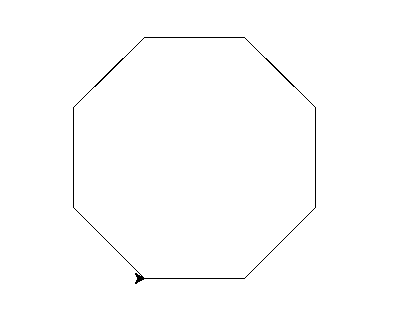
Note: Whenever submitting a turtle program, choose a name for your file that is not turtle.py. When executing the "import turtle" statement, the computer first looks in the folder where the file is saved for the turtle module and then in the libraries (and other places on the path). So, it thinks the module is itself, causing all kinds of errors. To avoid this, name your program something like "myTurtle.py" or "program2.py". - Due Date: September 12 Reading: Lab 1
Write a program that implements the pseudocode ("informal high-level description of the operating principle of a computer program or other algorithm") below:
Repeat 36 times: Walk forward 100 steps Turn left 145 degrees Walk forward 10 steps Turn right 90 degrees Walk forward 10 steps Turn left 135 degrees Walk forward 100 steps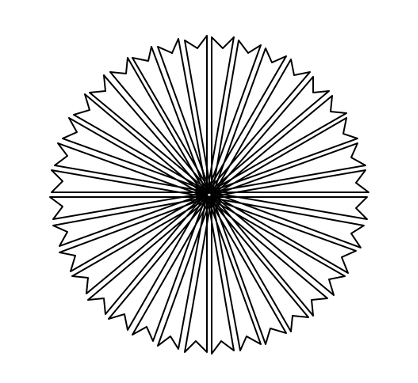
- Due Date: September 13 Reading: Lab 1
Write a program that will print "I love Python!" 25 times.
The output of your program should be:
I love Python! I love Python! I love Python! I love Python! I love Python! I love Python! I love Python! I love Python! I love Python! I love Python! I love Python! I love Python! I love Python! I love Python! I love Python! I love Python! I love Python! I love Python! I love Python! I love Python! I love Python! I love Python! I love Python! I love Python! I love Python!
- Due Date: September 16 Reading: Lab 1
Write a program that uses the turtle library to draw a 5-pointed star.
Your output should look like this:

Hint: To draw the 5-pointed star, the turtle must turn a total of 720 degrees. How many degrees does the turtle need to turn at each point?
- Due Date: September 17 Reading: Think CS
Section 4.7
Write a program that prints out the numbers from 2 to 17.
The output of your program should be:
2 3 4 5 6 7 8 9 10 11 12 13 14 15 16 17
- Due Date: September 24 Reading: Lab 2
Using the string commands introduced in Lab 2, write a Python program that prompts the user for a message, and then prints the message, the message in upper case letters, and the message in lower case letters.
A sample run of your program should look like:
Enter a message: Mihi cura futuri Mihi cura futuri MIHI CURA FUTURI mihi cura futuri
Another run:
Enter a message: I love Python! I love Python! I LOVE PYTHON! i love python!
Hint: Your program should be able to take any phrase the user enters and prints it, it in upper case letters, and it in lower case letters. To do that, you need to store the phrase in a variable and print variations of the stored variable.
- Due Date: September 26 Reading: Lab 2
Write a program that prompts the user to enter a phrase and then prints out the ASCII code of each character in the phrase.
A sample run of your program should look like:
Enter a phrase: I love Python! In ASCII: 73 32 108 111 118 101 32 80 121 116 104 111 110 33
And another sample run:
Enter a phrase: ABC In ASCII: 65 66 67
Hint: If c is a character, ord(c) returns its ASCII code. For example, if c is 'I', then ord(c) returns 73. See Lab 2.
- Due Date: September 27 Reading: Lab 3
Write a program that asks the user for the hexcode of a color and then displays a turtle that color.
Make sure the turtle is the correct shape by including turtle.shape("turtle") in your program.
A sample run of your program should look like:
Enter a hex string: #A922A9
and the output should look similar to:

- Due Date: September 30 Reading: Lab 3
Write a program that implements the pseudocode below:
For i = 5, 10, 15, 20, 25, ... ,300: Walk forward i steps Turn left 91 degreesYour output should look similar to:
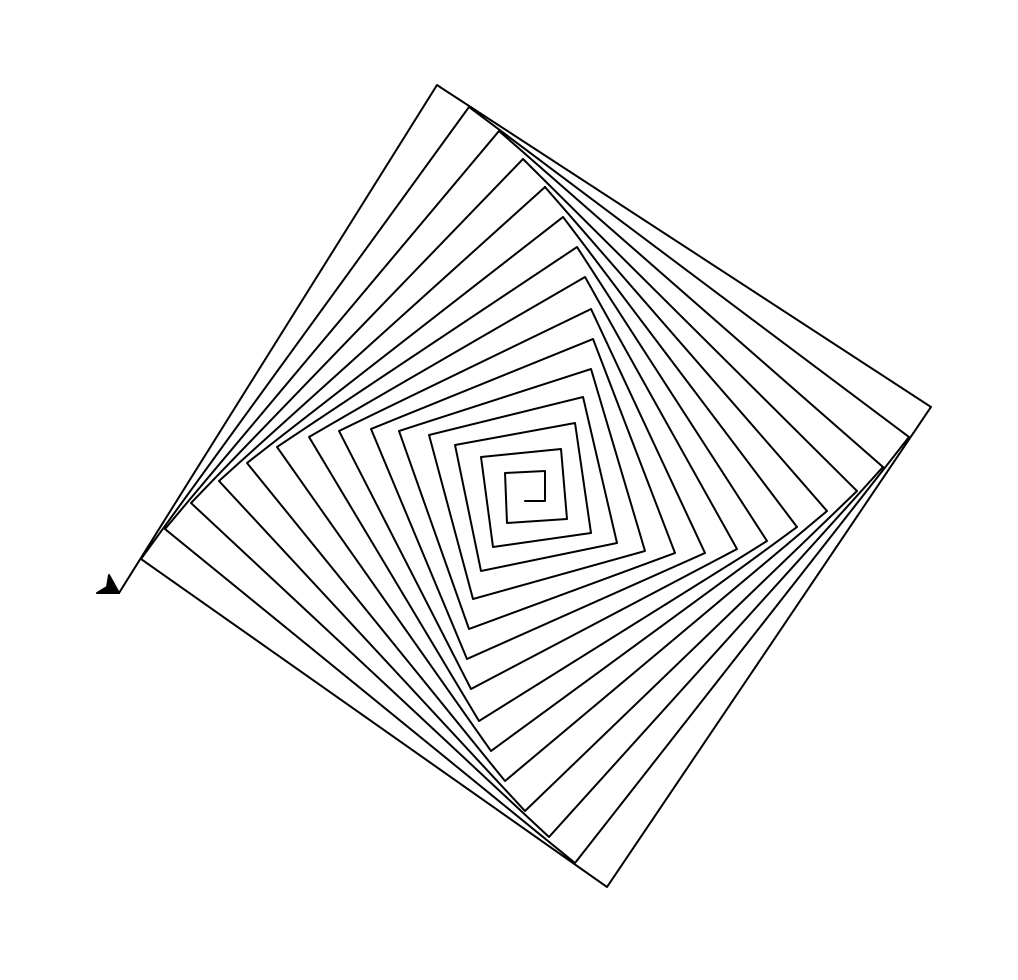
Hint: See examples of range(start,stop,step) in Lab 2.
- Due Date: October 1 Reading: Lab 3
Modify the program from Lab 3 to show the shades of blue.
Your output should look similar to:
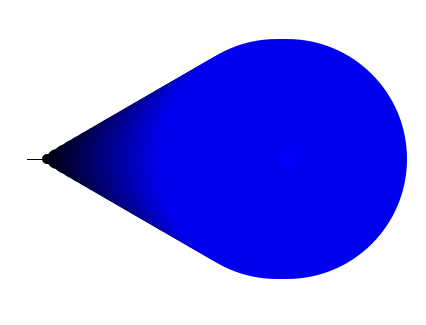
- Due Date: October 7 Reading: Lab 3
Draw a cornflower blue pentagon using the turtle library. You can specify the color by name ("cornflowerblue"), by hex string ("#6495ED"), or by 255-mode values (100, 149, 237). The turtle should be turtle shaped. Your turtle should move forward 100 units, turn left the correct amount of degrees, and then stamp.
A sample run of your program will look like:
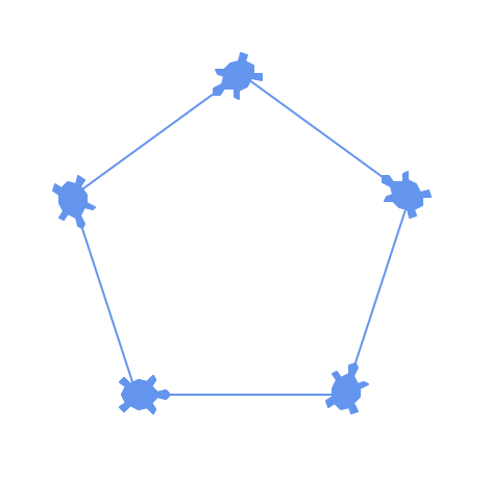
Hint: See Lab 3.
- Due Date: October 8 Reading: Lab 2
Write a program that asks the user for a message, then prints out that message in reverse. The reversed output message should be printed with two copies of each character per line.
A sample run of your program should look like:
Enter a message: I love Python! ! ! n n o o h h t t y y P P e e v v o o l l I I
Hint: use a for-loop that starts at the last index in the string and stops at the first index in the string:
lastIdx = len(myString) - 1 for i in range(lastIdx, -1, -1): #print each character in myString, twice on each line
- Due Date: October 9 Reading: Lab 4
Write a program that asks the user for 5 whole (integer) numbers. For each number, turn the turtle left the degrees entered and then the turtle should move forward 100.
A sample run of your program should look like:
Enter a number: 270 Enter a number: 100 Enter a number: 190 Enter a number: 200 Enter a number: 80
and the output should look similar to:
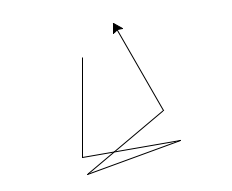
- Due Date: October 15 Reading

(The cipher disk above shifts 'A' to 'N', 'B' to 'O', ... 'Z' to 'M', or a shift of 13. From secretcodebreaker.com.)Write a program that prompts the user to enter a word and then prints out the word with each letter shifted right by 13. That is, 'a' becomes 'n', 'b' becomes 'o', ... 'y' becomes 'l', and 'z' becomes 'm'.
Assume that all inputted words are in lower case letters: 'a',...,'z'.
A sample run of your program should look like:
Enter a word: zebra Your word in code is: mroen
Hint: You can use this file to get started with this assignment.
- Due Date: October 16 Reading: Lab 4
Write a program that converts kilometers to miles. Your program should prompt the user for the number of kilometers and then print out the number of miles.
A useful formula: miles = 0.621371*kilometers.
- Due Date: October 22 Reading: Lab 4
Write a program that implements the pseudocode below:
1. Ask the user for the number of hours until the weekend. 2. Print out the days until the weekend (days = hours // 24) 3. Print out the leftover hours (leftover = hours % 24)
A sample run of your program should look like:
Enter number of hours: 27 Days: 1 Hours: 3
and another sample run:
Enter number of hours: 52 Days: 2 Hours: 4
Hint: See Section 2.7.
- Due Date: October 23 Reading: Lab 5
Following Lab 5, write a program that asks the user for the name of a png file and print the number of pixels that are nearly white (the fraction of red, the fraction of green, and the fraction of blue are all above 0.75).
For example, if your file was of the snow pack in the Sierra Nevada mountains in California in September 2014:
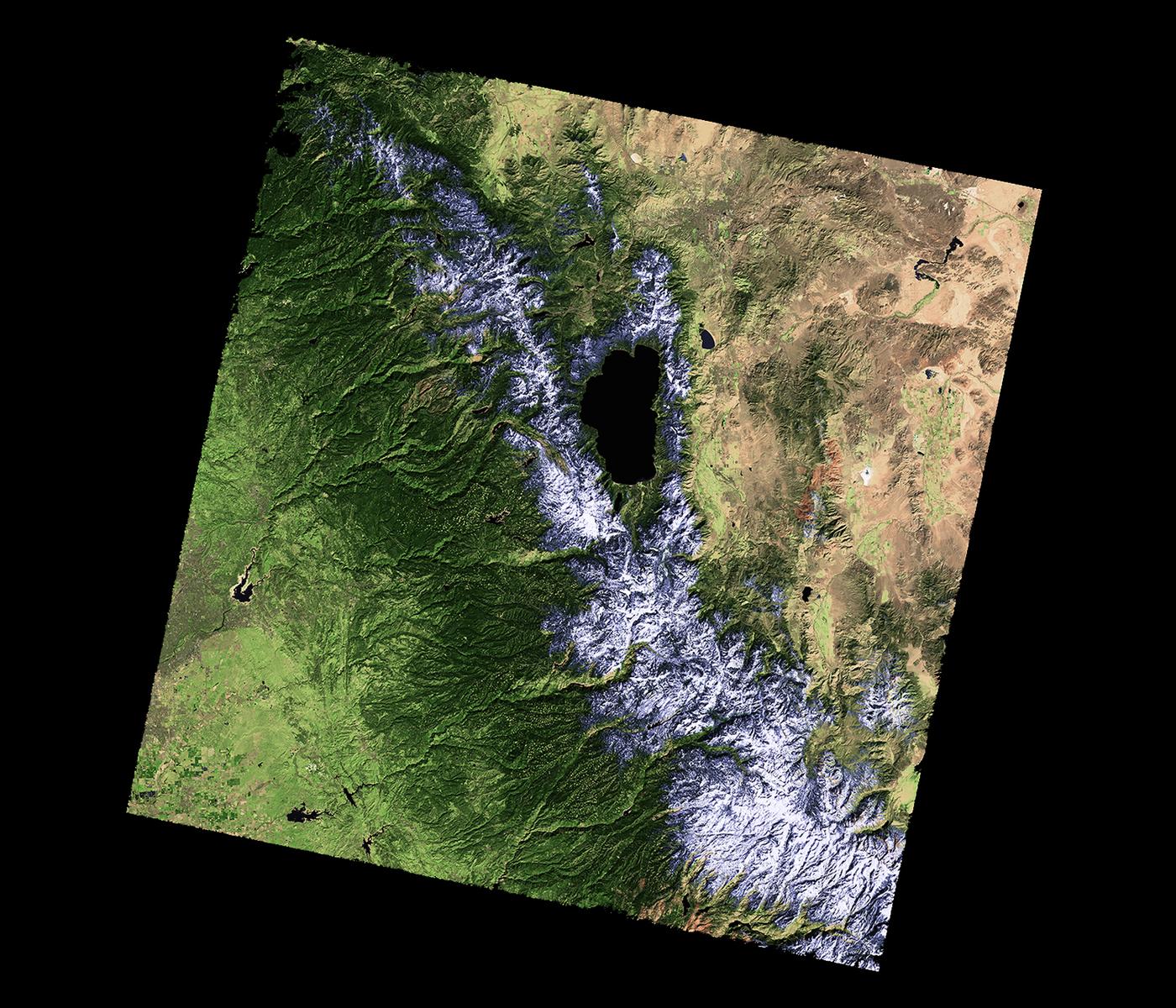
then a sample run would be:
Enter file name: caDrought2014.png Snow count is 38010
Note: for this program, you only need to compute the snow count. Showing the image will confuse the grading script, since it's only expecting the snow count.
- Due Date: October 28 Reading: Lab 2 and Lab 4
We can store DNA sequences as strings. These strings are made up of the letters A, C, G, and T. For a given DNA string, the GC-content is the percent of the string that is C or G, written as a decimal.
Write a program that prompts the user for a DNA string, and then prints the length and GC-content of that string.
A sample run of the program:
Enter a DNA string: ACGCCCGGGATG Length is 12 GC-content is 0.75
Hint: You can use a for-loop to go through each character in the string, and count each time you encounter a 'C' or 'G'. You can use an if-statment to check what kind of character the loop is currently on. Alternatively, you can use the count() method introduced in Lab 2 to get the total occurrences of 'C' and 'G' in the string.
- Due Date: October 29 Burch's Logic & Circuits
Build a circuit that has the same behavior as a nand gate (i.e. for the same inputs, gives identical output) using only and, or, and not gates.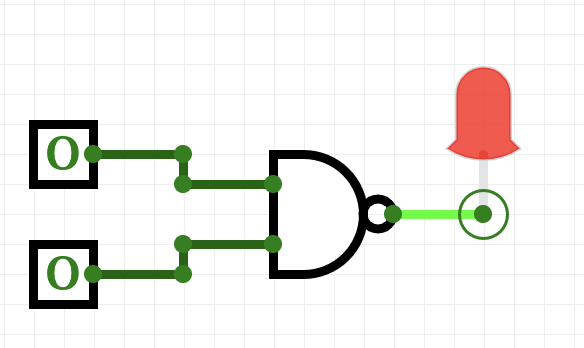
Save your expression to a text file. See Lab 5 for the format for submitting logical expressions to Gradescope.
- Due Date: October 30 Burch's Logic & Circuits
Build a circuit that has the same behavior as a nor gate (i.e. for the same inputs, gives identical output) using only and, or, and not gates.
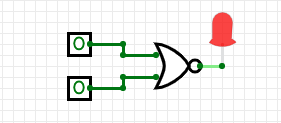
Save your expression to a text file. See Lab 5 for the format for submitting logical expressions to Gradescope.
- Due Date: October 31 Burch's Logic & Circuits
Write a logical expression that is equivalent to the circuit that computes the majority of 3 inputs, called in1, in2, in3:
- If two or more of the inputs are True, then your expression should evaluate to True.
- Otherwise (two or more of the inputs are False), then your expression should evaluate to False.
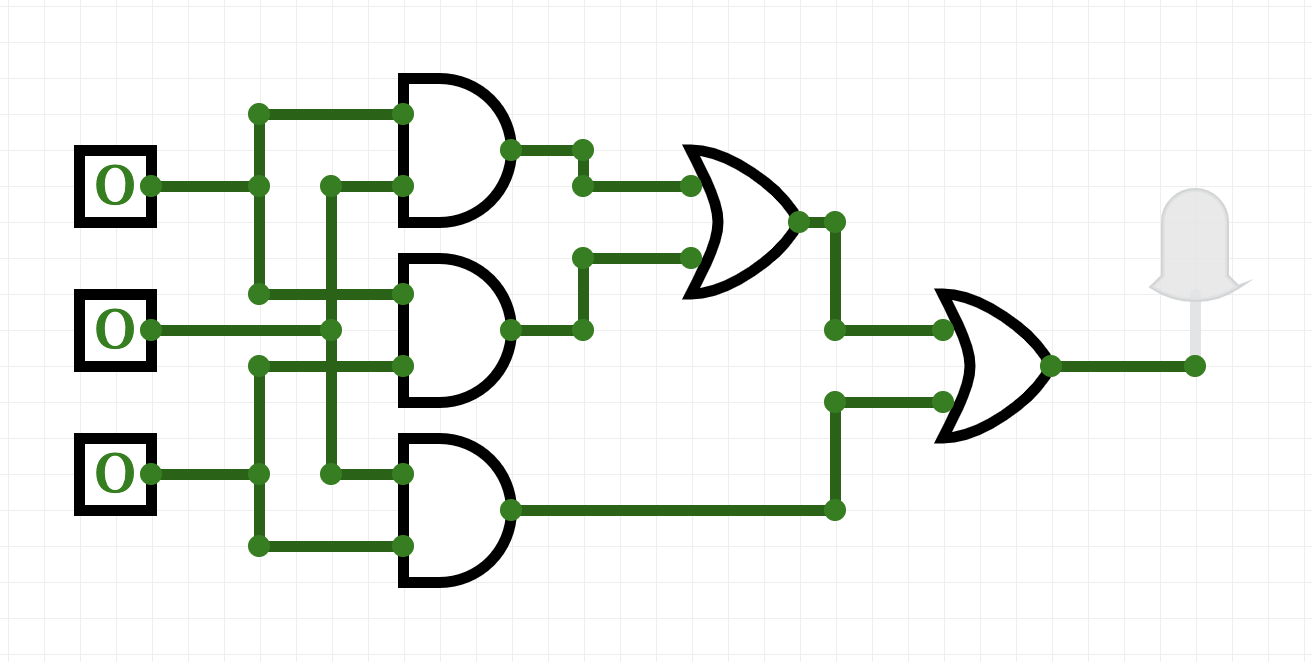
Save your expression to a text file. See Lab 5 for the format for submitting logical expressions to Gradescope.
- Due Date: November 1 Reading: Lab 5
Logical gates can be used to do arithmetic on binary numbers. For example, we can write a logical circuit whose output is one more than the inputted number. Our inputs are in1 and in2 and the outputs are stored in out1, out2, and out3.

Here is a table of the inputs and outputs:
Inputs Outputs Decimal
Numberin1 in2 Decimal
Numberout1 out2 out3 0 0 0 1 0 0 1 1 0 1 2 0 1 0 2 1 0 3 0 1 1 3 1 1 4 1 0 0 Submit a text file with each of the outputs on a separate line:
#Name: YourNameHere #Date: October 2024 #Logical expressions for a 4-bit incrementer out1 = ... out2 = ... out3 = ...
Where "..." is replaced by your logical expression (see Lab 5).Note: here's a quick review of binary numbers.
- Due Date: November 4 Think CS: Chapter 4 & Section 7.4
The program turtleString.py takes a string as input and uses that string to control what the turtle draws on the screen (inspired by code.org's graph paper programming). Currently, the program processes the following commands:
- 'F': moves the turtle forward 50 steps
- 'L': turns the turtle 90 degrees to the left
- 'R': turns the turtle 90 degrees to the right
- '^': lifts the pen
- 'v': lowers the pen
Modify this program to allow the user also to specify with the following symbols:
- 'B': moves the turtle backwards 50 steps
- 'S': makes the turtle stamp
- 'l': turns the turle 45 degrees to the left
- 'r': turns the turtle 45 degrees to the right
- 'p': change the pen color to purple
- Due Date: November 5
GitHub Guide
In Lab 6, you created a GitHub account. Submit a text file with the name of your account. The grading script is expecting a file with the format:
#Name: Your name #Date: October 2024 #Account name for my GitHub account AccountNameGoesHere
Note: it takes a few minutes for a newly created GitHub account to be visible. If you submit to Gradescope and get a message that the account doesn't exist, wait a few minutes and try again.
- Due Date: November 14
Lab 3
Write a program that asks the user for a name of an image .png file and the name of an output file. Your program should create a new image that has only the blue channel of the original image (that is, no green channel).
A sample run of your program should look like:
Enter name of the input file: csBridge.png Enter name of the output file: blueH.png
Sample input and resulting output files:
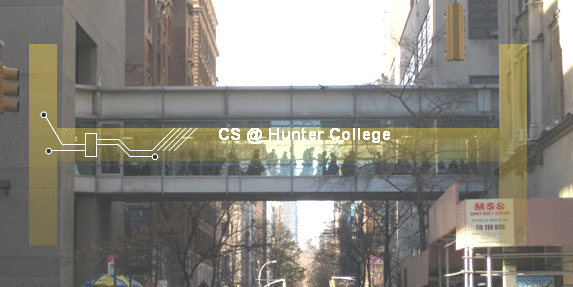
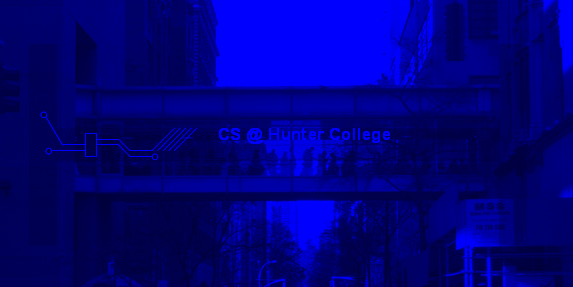
Note: before submitting your program for grading, remove the commands that show the image (i.e. the ones that pop up the graphics window with the image). The program is graded on a server on the cloud and does not have a graphics window, so, the plt.show() and plt.imshow() commands will give an error. Instead, the files your program produces are compared pixel-by-pixel to the answer to check for correctness.
- Due Date: December 18
Reading:
Write a program that implements the pseudocode below:
For i = 90, 88, 86, 84, 82, ... ,0: Walk forward 25 steps Turn left i degrees
Your output should look similar to:

- Due Date: December 18
Reading:
Write a program that creates a 'C' logo for CUNY on a 30x30 grid.

The grading script is expecting:
- The file to be saved as: logo.png.
- The grid to be 30 x 30.
- The 'C' to be 0% red, 0% green, and 100% blue. The upper part of the 'C' should be the top third of the image; the left part of the 'C' should be the left third of the image; and the lower part of the 'C' should be the the bottom third of the image.
- The remaining pixels in the image should be white (100% red, 100% green, and 100% blue).
Note: before submitting your program for grading, remove the commands that show the image (i.e. the ones that pop up the graphics window with the image). The program is graded on a server on the cloud and does not have a graphics window, so, the plt.show() and plt.imshow() commands will give an error. Instead, the files your program produces are compared pixel-by-pixel to the answer to check for correctness.
- Due Date: December 18
Reading:
Modify the flood map of NYC from Lab 4 to color the region of the map with elevation greater than 6 feet and less than or equal 20 feet above sea level the color grey (50% red, 50% green, and 50% blue).
Your resulting map should look like:

and be saved to a file called floodMap.png.
Note: before submitting your program for grading, remove the commands that show the image (i.e. the ones that pop up the graphics window with the image). The program is graded on a server on the cloud and does not have a graphics window, so, the plt.show() and plt.show() commands will give an error. Instead, the files your program produces are compared pixel-by-pixel to the answer to check for correctness.
- Due Date: December 18
Reading:
Write a program that computes the minimum, average, and maximum population over time for a borough (entered by the user). Your program should assume that the NYC historical population data file, nycHistPop.csv is in the same directory.
A sample run of your program:
Enter borough: Staten Island Minimum population: 727 Average population: 139814.23076923078 Maximum population: 474558
and another run:
Enter borough: Brooklyn Minimum population: 2017 Average population: 1252437.5384615385 Maximum population: 2738175
Hint: See Lab 6.
- Due Date: December 18
Reading:
Write a program that prompts the user to enter a list of names. Each person's name is separated from the next by a semi-colon and a space ('; ') and the names are entered lastName, firstName (i.e. separated by ', '). Your program should then print out the names, one per line, with the first initial of the first name, followed by ".", and followed by the last name.
A sample run of your program should look like:
Please enter your list of names: Cohn, Mildred; Dolciani, Mary P.; Rees, Mina; Teitelbaum, Ruth; Yalow, Rosalyn You entered: M. Cohn M. Dolciani M. Rees R. Teitelbaum R. Yalow Thank you for using my name organizer!
Hint: Do this problem in parts: first, split the list by person (what should the delimiter be?). Then, split each of person's name into first and last name (what should the delimiter be here?). If you have a string str, what is s = str[0] + "."?
- Due Date: December 18
Reading:
Modify the map-mapking program from Lab 4 to create a topographic map (highlighting the points that have elevations that are multiples of 10). Your program should ask the user for the amount of blue (a floating point number between 0.0 and 1.0), the name of the output imagee, create a new image with thaht name and with the pixels colored as follows:
- If the elevation is less than or equal to 0, color the pixel the amount blue the user specified (and 0% red and 0% green).
- If the elevation is divisible by 10, color the pixel black (0% red, 0% green, and 0% blue).
- Otherwise, the pixel should be colored white (100% red, 100% green, and 100% blue).
A sample run of your program should look like:
How blue is the ocean: 0.5 What is the output file: medBlue.png Thank you for using my program! Your map is stored medBlue.png.
Your resulting map should look like:

and be saved to a file called medBlue.png.
Note: before submitting your program for grading, remove the commands that show the image (i.e. the ones that pop up the graphics window with the image). The program is graded on a server on the cloud and does not have a graphics window, so, the plt.show() and plt.imshow() commands will give an error. Instead, the files your program produces are compared pixel-by-pixel to the answer to check for correctness.
- Due Date: December 18
Reading:
Modify the program from Lab 6 that displays the NYC historical population data. Your program should ask the user for the borough, an name for the output file, and then display the fraction of the population that has lived in that borough, over time.
A sample run of the program:
Enter borough name: Queens Enter output file name: qFraction.png
The file qFraction.png:
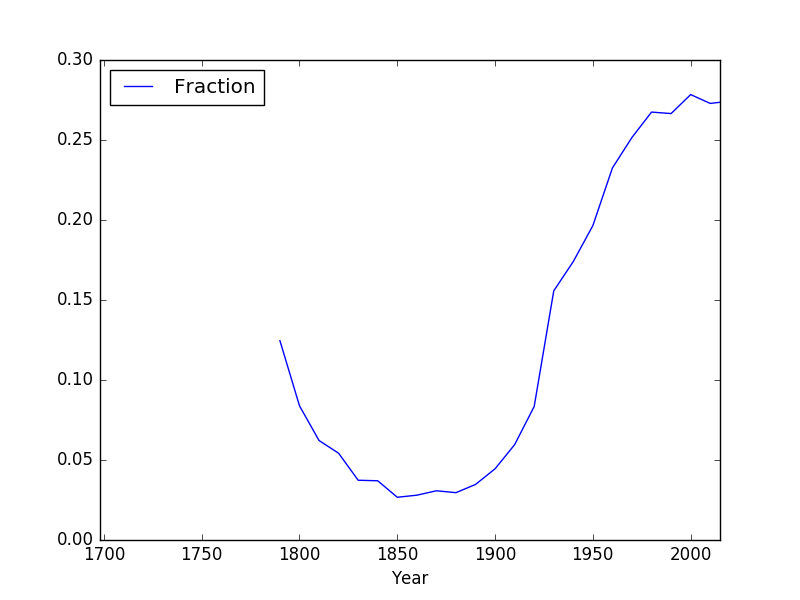
Note: before submitting your program for grading, remove the commands that show the image (i.e. the ones that pop up the graphics window with the image). The program is graded on a server on the cloud and does not have a graphics window, so, the plt.show() and plt.imshow() commands will give an error. Instead, the files your program produces are compared pixel-by-pixel to the answer to check for correctness.
- Due Date: December 18
Reading:
Write a program that implements the pseudocode below:
1. Ask the user for the number of seconds until lecture starts. 2. Print out the hours until lecture (hours = seconds //3600). 3. Compute the remaining seconds (rem = seconds % 3600). 4. Print out the minutes until lecture (minutes = rem // 60). 5. Print out the remaining seconds (remSec = rem % 60).
A sample run of your program should look like:
Enter number of seconds: 62 Hours: 0 Minutes: 1 Seconds: 2
and another sample run:
Enter number of seconds: 4000 Hours: 1 Minutes: 6 Seconds: 40
- Due Date: December 18
Reading:
Write a Bash script that prints Hello, World to the screen.
Submit a single text file containing your Unix shell commands. See Lab 6 for details.
- Due Date: December 18
Reading:
Modify the parking ticket program from Lab 8 to do the following:
- Ask the user for the name of the input file.
- Ask the user for the attribute (column header) to search by.
A sample run:
Enter file name: Parking_Violations_Jan_2016.csv Enter attribute: Vehicle Color The 10 worst offenders are: WHITE 2801 WH 2695 GY 1420 BK 1153 BLACK 1054 BROWN 727 BL 656 GREY 574 SILVE 450 BLUE 412 Name: Vehicle Color, dtype: int64
And another run:
Enter file name: Parking_Violations_Jan_2016.csv Enter attribute: Vehicle Year The 10 worst offenders are: 0 3927 2015 1265 2014 1143 2013 1105 2012 772 2011 666 2007 643 2008 559 2010 509 2006 499 Name: Vehicle Year, dtype: int64
- Due Date: December 18
Reading:
Write a program that implements the pseudcode below. Your program should ask the user for a binary number and print out the corresponding decimal number.
Ask user for input, and store in the string, binString. Set decNum = 0. For each c in binString, decNum = decNum * 2 if c is 1, then decNum = decNum + 1 Print decNumA sample run of the program:
Enter binary number: 10 Your number in decimal is 2
And another sample run of the program:
Enter binary number: 1111 Your number in decimal is 15
- Due Date: December 18
Reading:
Fill in the missing functions:
- average(region): Takes a region of an image and returns the average red, green, and blue values across the region.
- setRegion(region,r,g,b): Takes a region of an image and red, green, and blue values, r, g, b. Sets the region so that all points have red values of r, green values of g, and blue values of b.
The functions are part of a program that averages smaller and smaller regions of an image until the underlying scene is visible (inspired by the elegant koalas to the max).
For example, if you inputted our favorite image, you would see (left to right):
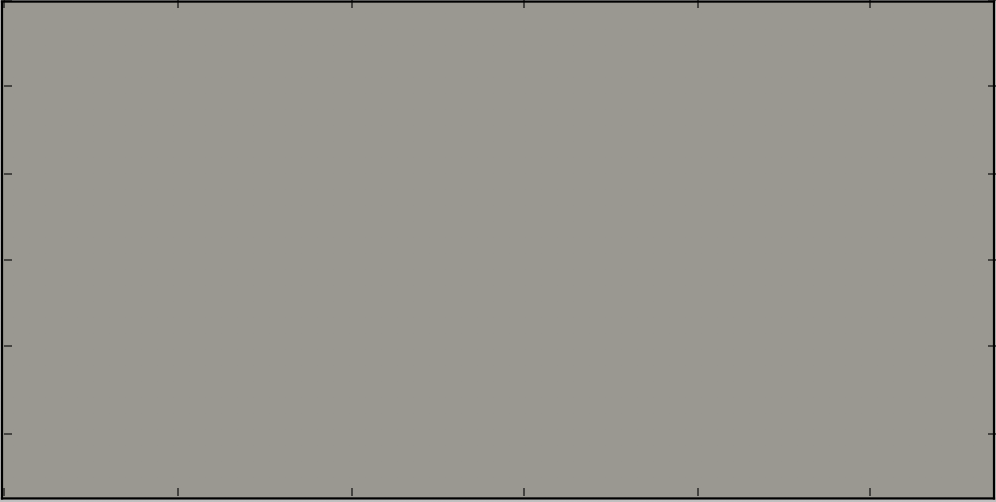

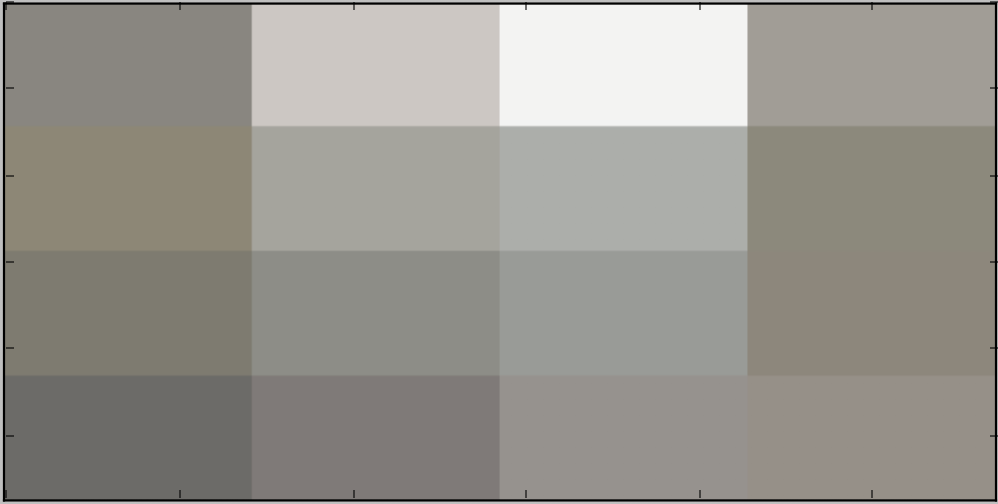

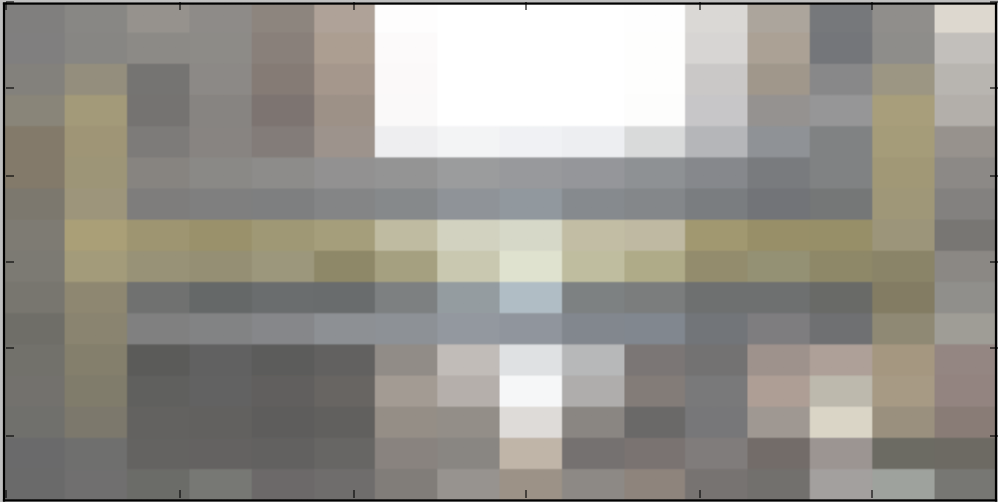
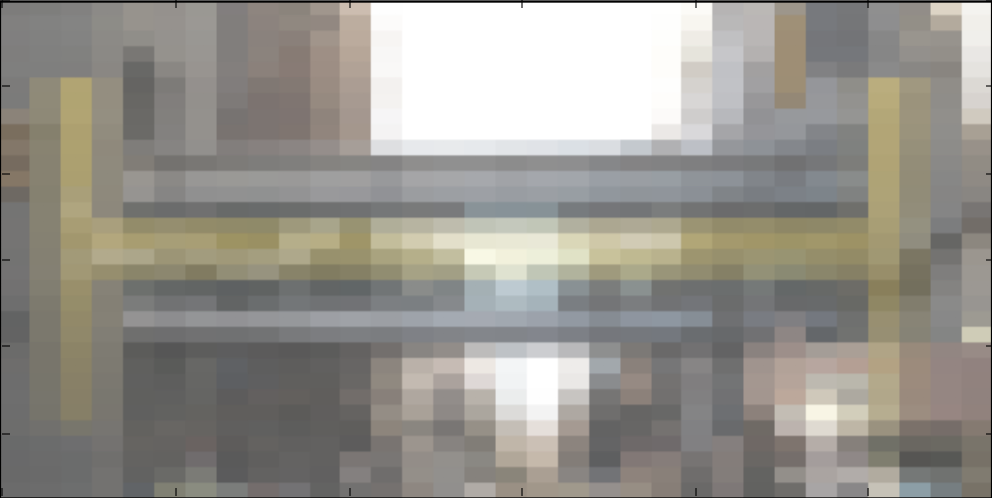
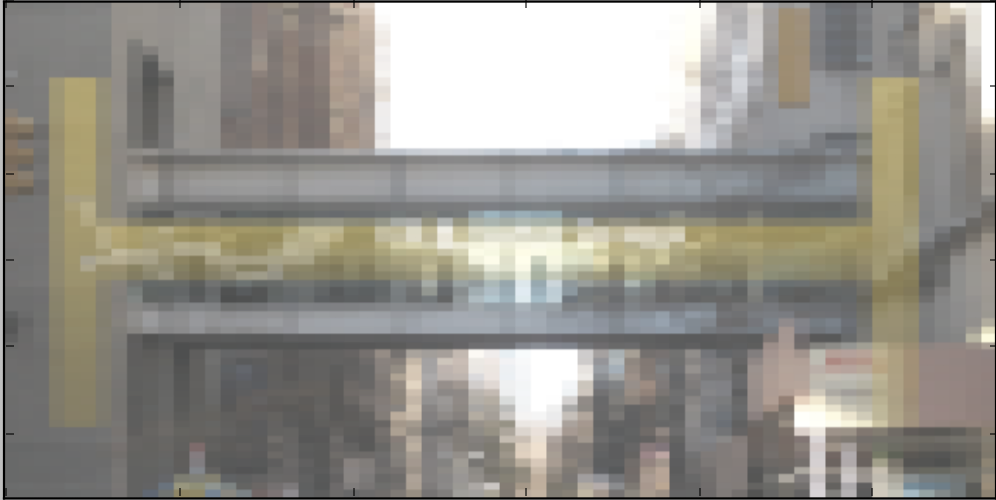
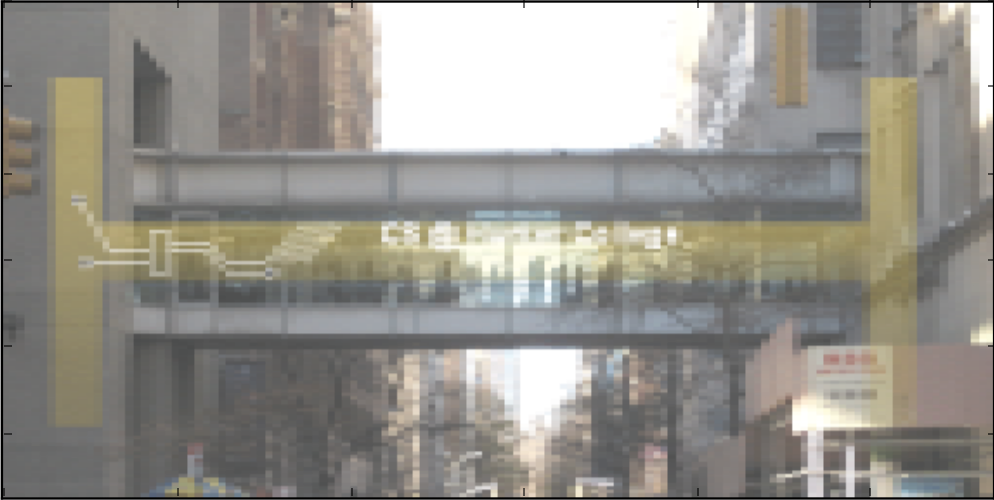
and finally:

A template program, averageImage.py, is available here. You should use this file to get started with your program.
The grading script does not run the whole program, but instead runs each of your functions separately ('unit tests') to determine correctness. As such, the names of the functions must match exactly the ones listed above (else, the scripts cannot find them).
- Due Date: December 18
Reading:
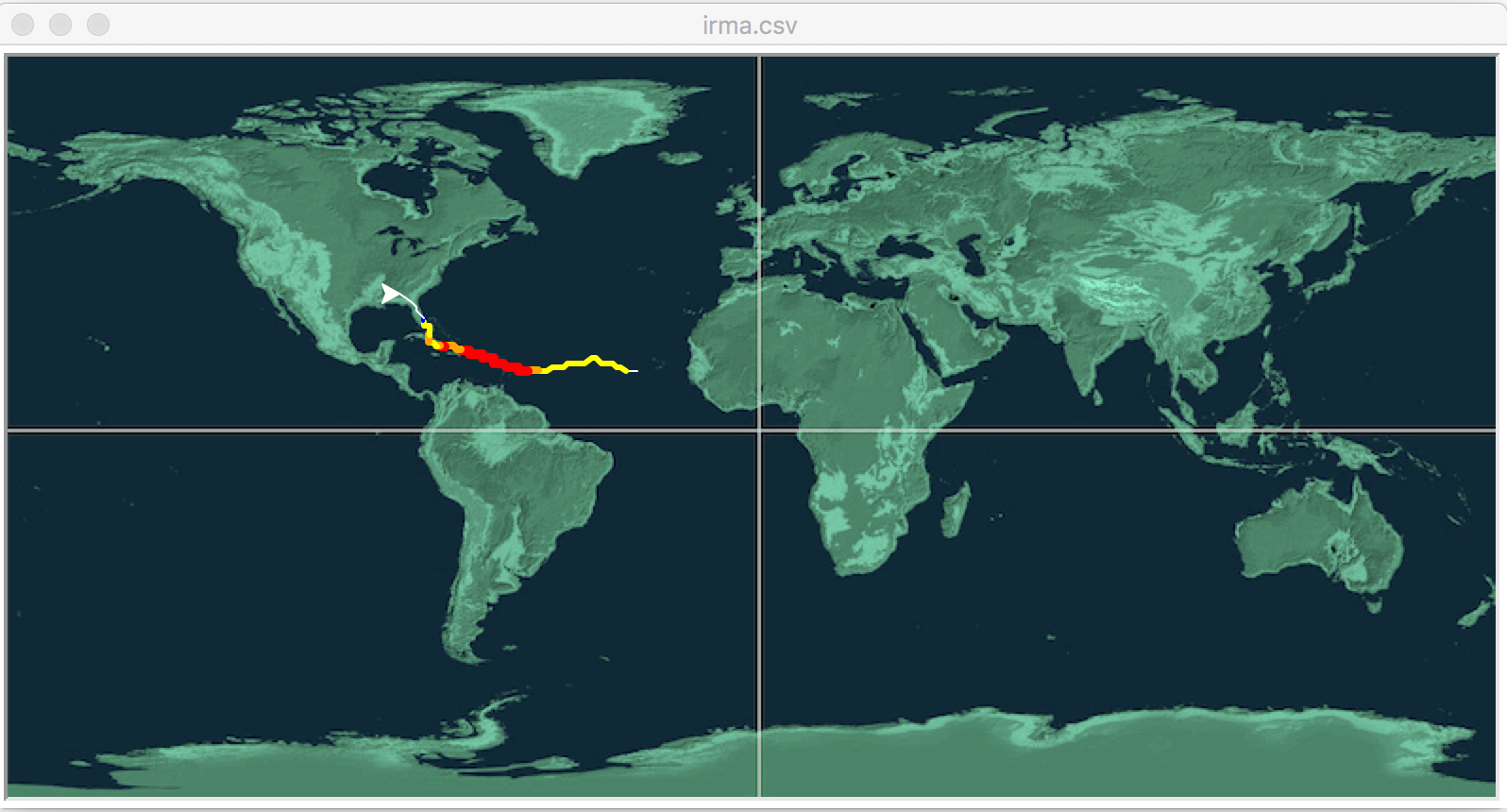
Fill in the missing function to animate hurricane data (inspired by the 2018 Nifty Hurricane Program by Phil Ventura). Your function, animate(t,lat,lon,wind) takes as input:
- t: a turtle,
- lat: an integer storing the current latitude,
- lon: an integer storing the current longitude, and
- wind: the current wind speed in miles per hour.
Your function should move to the turtle to the current location (longitude, latitude), and then based on the Saffir-Simpson Hurricane Wind Scale, change the turtle to be:
- red and pen size 5 for Category 5 (windspeed > 157 mph)
- orange and pen size 4 for Category 4 (windspeed in 130-156 mph)
- yellow and pen size 3 for Category 3 (windspeed in 111-129 mph)
- green and pen size 2 for Category 2 (windspeed in 96-110 mph)
- blue and pen size 1 for Category 1 (windspeed in 74-95 mph)
- white and pen size 1 if not hurricane strength
Download the template program, hurricane.py using this link. You will also need to download the background image, mapNASA.gif (link here), and put it in the same directory as hurricane.py.
The grading script does not run the whole program, but instead runs each of your functions separately ('unit tests') to determine correctness. As such, the names of the functions must match exactly the ones listed above (else, the scripts cannot find them).
Two test files (irma.csv and jose.csv) are from the Nifty site. Additional CSV files are available there.
Hint: You may find the following turtle commands useful: color(), goto(), and pensize().
- Due Date: December 18
Reading:
Modify the program from Lab 10 that makes a turtle walk 100 times. Each "walk" is 30 steps forward and the turtle can turn left 0,10,20,...,350 degrees (chosen randomly) at the beginning of each walk.
A sample run of your program:
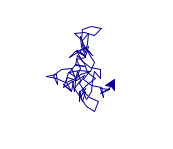
- Due Date: December 18
Reading:
Write a C++ program that prints "Hello, World!" to the screen.
Hint: See Lab 12 for getting started with C++.
- Due Date: December 18
Reading: Lab 11
Using the weMIPS assembly language, write a program that loops through the numbers 2, 4, 6, 8, ..., 20.
- Due Date: December 18
Reading: Lab 11
Using the weMIPS assembly language, write a program that prints the string "Hello, World!" to the screen.
- Due Date: December 18
Reading: Lab 6
Write a Bash script that makes a new directory called projectFiles , enters the directory, then creates three more subdirectories titled source, data, and results.
- Due Date: December 18
Reading: Lab 9
Fix all of the errors in the file errorsHex.py and then upload the file to Gradescope.
- Due Date: December 18
Reading:
Write two functions, triangle() and nestedTriangle(). Both functions take two parameters: a turtle and an edge length. The pseudocode for triangle() is:
triangle(t, length): 1. If length > 10: 2. Repeat 3 times: 3. Move t, the turtle, forward length steps. 4. Turn t left 120 degrees. 5. Call triangle with t and length/2.The pseudocode for nestedTriangle() is very similar:
nestedTriangle(t, length): 1. If length > 10: 2. Repeat 3 times: 3. Move t, the turtle, forward length steps. 4. Turn t left 120 degrees. 5. Call nestedTriangle with t and length/2.A template program, nestingTrianges.py, is available here on GitHub. The grading script does not run the whole program, but instead tests your function separately ('unit tests') to determine correctness. As such, the function names must match exactly (else, the scripts cannot find it). Make sure to use the function names from the GitHub program (it is expecting triangle() and nestedTriangle()).
A sample run:
Enter edge length: 160
which would produce:
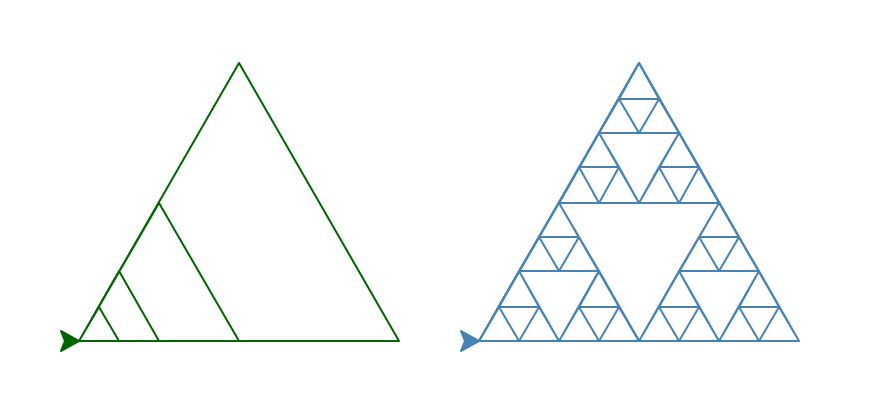
- Due Date: December 18
Reading:
Validate the user's input such that they are required to enter a non-negative integer.
- Due Date: December 18
Reading: Lab 12
Write a C++ program that asks the user for a year, and continue asking until the number entered that is 2018 or earlier.
A sample run:
Enter year: 2023 Year must be 2018 or earlier Enter year: 2025 Year must be 2018 or earlier Enter year: 2000 You entered: 2000
Hint: See Lab 10 for similar programs in Python. Rewrite in C++.
- Due Date: December 18
Reading:
Write a complete C++ program that prints the string "I love C++" 14 times. Each copy of the string should be on a new line.
- Due Date: December 18
Reading: Lab 13
Write a C++ program that asks the user for the month of the year (as a number), and prints
- "Happy Winter" if it is strictly before 3 or strictly larger than 11,
- "Happy Spring" if it is 3 or greater, but strictly before 7, and
- "Happy Summer" if it is 7 or greater, but strictly before 9, and
- "Happy Fall" otherwise.
A sample run:
Enter month (as a number): 12 Happy Winter
Another sample run:
Enter month (as a number): 8 Happy Summer
And another run:
Enter month (as a number): 11 Happy Fall